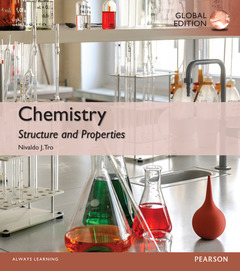Description
Chemistry: Structure and Properties, Global Edition
Author: Tro Nivaldo
Language: English
Subject for Chemistry: Structure and Properties, Global Edition:
1144 p. · 24.5x27.5 cm · Paperback
Description
/li>Contents
/li>Comment
/li>
For two-semester general chemistry courses
Bestselling author Nivaldo Tro has always believed ?the behaviour of matter is determined by the properties of molecules and atoms? to be the most important discovery in scientific knowledge. This idea is the entire factor for his seminal new text?Chemistry: Structure and Properties. Dr. Tro emphasises the relationship between structure and properties, establishes a unique approach to teaching chemistry by presenting atomic and bonding theories early in the text, and stresses key themes throughout. The book is organised to present chemistry as a logical, cohesive story from the microscopic to the macroscopic, so students can fully grasp the theories and framework behind the chemical facts. Every topic has been carefully crafted to convey to students that the relationship between structure and properties is the thread that weaves all of chemistry together.
While developed independently of other Tro texts, Chemistry: Structure and Properties incorporates the author?s vivid writing style, chemical rigor, dynamic multi-level images, and tested features. His consistent conceptual focus and step-by-step problem-solving framework encourages students to think through processes rather than simply memorise content.
This program presents a better teaching and learning experience?for you and your students.
- Developed with a central theme and by a teaching community: As part of a community that teaches with the understanding that matter is composed of particles and the structure of those particles determines the properties of matter, Dr. Tro took great lengths in the text to ensure that everything from organisation, art, and pedagogy reinforce this theme. The result of this emphasis is that the topic order has been constructed to make key connections earlier, stronger, and more often than the traditional approach.
- Linking conceptual understanding with problem-solving skills: Throughout each chapter, numerous Conceptual Connections encourage comprehension of the most complex concepts while a consistent step-by-step framework in the worked examples allows students to think logically through the problem-solving process.
- Visualising and understanding chemistry: Revolutionary multipart images illustrate and reinforce the theme of the text and allow students to see and experience the molecules responsible for the structures and properties of matter.
- 1 Atoms
- 2 Measurement, Problem Solving, and the Mole Concept
- 3 The Quantum-Mechanical Model of the Atom
- 4 Periodic Properties of the Elements
- 5 Molecules and Compounds
- 6 Chemical Bonding I: Drawing Lewis Structures and Determining Molecular Shapes
- 7 Chemical Bonding II: Valence Bond Theory and Molecular Orbital Theory
- 8 Chemical Reactions and Chemical Quantities
- 9 Introduction to Solutions and Aqueous Reactions
- 10 Thermochemistry
- 11 Gases
- 12 Liquids, Solids, and Intermolecular Forces
- 13 Phase Diagrams and Crystalline Solids
- 14 Solutions
- 15 Chemical Kinetics
- 16 Chemical Equilibrium
- 17 Acids and Bases
- 18 Aqueous Ionic Equilibrium
- 19 Free Energy and Thermodynamics
- 20 Electrochemistry
- 21 Radioactivity and Nuclear Chemistry
- 22 Organic Chemistry
- 23 Transition Metals and Coordination Compounds
- Appendix I The Units of Measurement
- Appendix II Significant Figures
- Appendix III Common Mathematical Operations in Chemistry
- Appendix IV Useful Data
- Appendix V Answers to Selected Exercises
- Appendix VI Answers to In-Chapter Practice Problems
- Glossary
- Credits
- Index
Developed with a central theme and by a teaching community
- Emphasising the particulate nature of matter and more specifically how structure affects properties, Dr. Tro consulted–on everything from content and organisation to art and pedagogy–with a community of instructors who teach their general chemistry courses with an atoms-first approach
- Unlike in other atoms-first texts, the theme of structure affecting properties is carried throughout the entire book, including the topics commonly taught in the second half of the course, in order to consistently emphasise the theme and present topics in a logical progression.
- Art has also been carefully selected to best demonstrate visually the relationship between microscopic and macroscopic.
- Over 250 instructors teaching with an atoms-first approach were involved in the development of the text including:
- 2,000 students were also involved in development by class testing chapter and providing detailed reviews.
- 150 reviewers
- 75 class testers
- 50 focus group participants
- Conceptual Connections reinforce conceptual understanding of the most complex concepts in each chapter while the consistent step-by-step framework within the in-chapter worked examples encourages students to think logically through the problem-solving process
- Each chapter includes several Conceptual Connections, in which students are asked to think about key concepts and solve problems without doing any math.
- Tro’s four-step “Sort, Strategise, Solve, and Check” approach helps students connect the concept of the problem to its solution by developing an explicit conceptual plan for each problem. This method helps students understand where to start when given a problem and to think through the solution rather than simply formula hunting based o
These books may interest you

Chemistry A Molecular Approach 308.12 €



